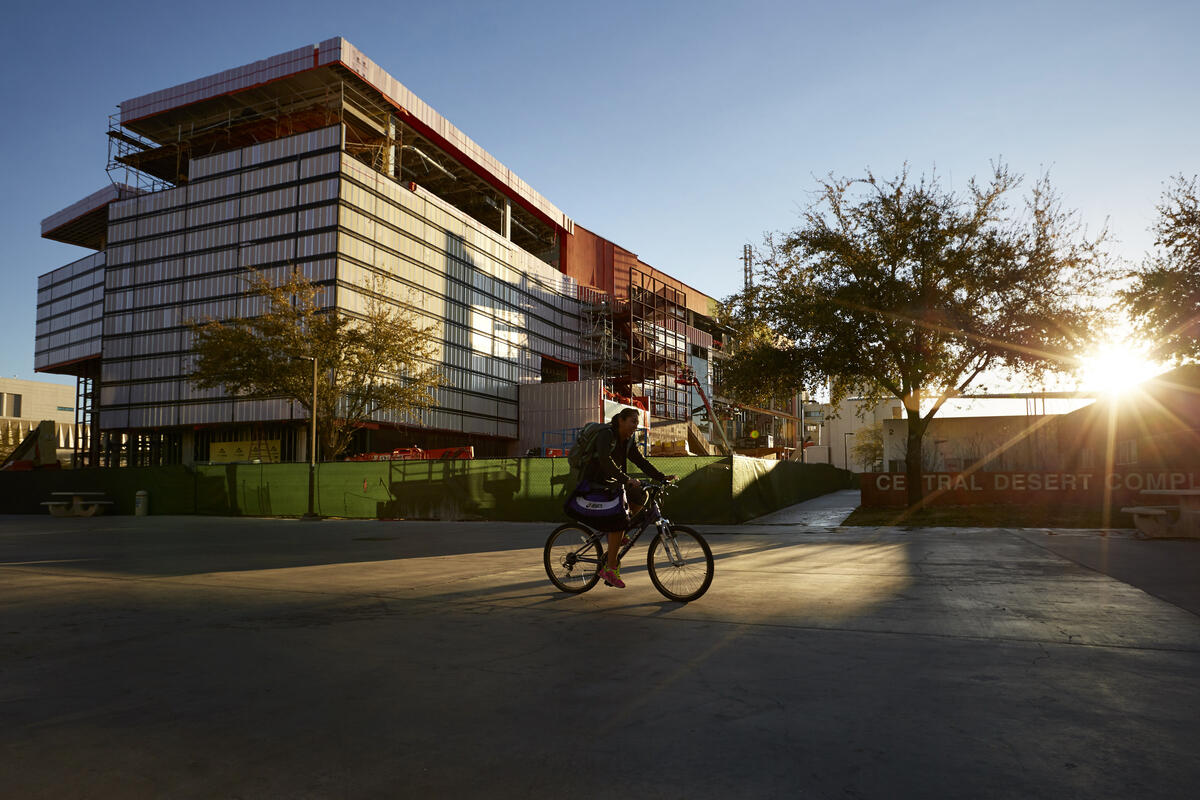You don’t have to squint anymore.
A few months ago, you had to narrow your eyes and use your imagination to get a bead on what Hospitality Hall was going to look like when it was all said and done. Now, with drywall starting to be applied; electrical and plumbing roughed in; a cooling tower in place, the building is starting to look like, well, a building.
“Right now you see a lot of pink and orange. That's insulation and paper barrier. You'll start to see the finished panels,” University Architect David Frommer said. “A lot of it will look finished in September. It's going to start cooking now, in terms of what you see.”
Everything is on track for construction on Hospitality Hall to wrap up in October and furniture and equipment installation to begin soon after. That will have everything ready for classes in the spring semester, with faculty checking out their new digs slightly before that.
With the William F. Harrah College of Hotel Administration vacating Frank and Estella Beam Hall, that does open up some space for other programs. But don’t expect a significant overhaul — just a minor refresh.
“A lot of the space being vacated is office space,” Frommer said. “The dining rooms are staying there. It's a lot of the hotel space in the office tower. It wouldn't make a whole lot of sense to go in and do major renovations.”
At the Center of Campus
With the Environmental Protection Agency slowly withdrawing from campus, the university has started to reclaim some of those buildings. The Environmental Assessment Exposure building — the one with the corrugated steel exterior furthest west along Harmon Avenue — will be demolished in the spring to make way for new parking, which is expected to come online for the fall semester, subject to bidding and funding ability.
Built in 1966, the five EPA buildings are owned by the university and have been leased to the government agency as research and lab space since its inception. The EPA’s original lease was up on Sept. 30, 2015, pending cleanup of radioactive and hazardous materials. The agency is expected to leave campus entirely within four years, and the university will reclaim the space piece by piece, eventually turning it into academic and research space, but the exact nature of that has yet to be determined.
The Changing Parkway
The U District is working toward having its apartments near Maryland Parkway and Flamingo Road, just south of the Tiffany Square strip mall completed by the fall. Units can be leased now; stop by the Student Union, Room 121.
At University Gateway, on the east side of Maryland, the parking garage opened in October, and developers are working out a second, multi-story, phase for the project that would include retail, office, and potentially even hotel space.
UNLV has a lease with purchase option on the second-level office space, Frommer said.
The space may one day house programs such as the Office of Community Engagement, the Graduate College, and the Marriage & Family Therapy Program. Placing clinical practices in offices accessible to the public without having to find parking and delve deep into campus will help those programs thrive, Frommer said. Police Services is also slated to relocate once the development is completed.

The Burgeoning Medical District
At the Shadow Lane campus, Building B has been remodeled for the School of Medicine’s academic space and faculty have moved into nearby leased offices. A nine-acre site is being prepped for the school’s future academic building. The old county health district buildings on the site have been demolished. Assuming all fundraising comes through as planned, groundbreaking on the new medical building could happen in 2018 or 2019, with an expected completion date around 2021.
Fundraising is an ever-present issue with campus construction, and it’s the first-and-foremost concern with proposed engineering and business buildings, both in the very early planning stages. Those facilities will likely be built with a combination of state and private funds.
The Fertitta Football Complex, on the other hand, will be built fully through donations. With last fall’s $10 million donation, the project is in its final stages of fundraising.
“The design of the facility is largely complete,” Frommer said. “The process now is determining the most effective way of delivery of that. The private sector donors deliver the building through their funding. It’s got no state money or public money in it, so we’re looking at how that structure can work. There’s a little more fundraising to go, but there’s been a lot of momentum.”



